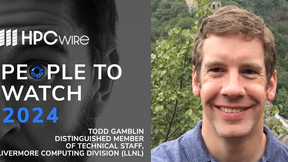Andreas Kemp receives 2014 ASCR Leadership Computing Challenge award
 (Download Image)
(Download Image)
A team of researchers led by Andreas Kemp has been awarded 30 million CPU hours on Oak Ridge National Laboratory's Titan Cry XK7 supercomputer to further pursue the study of short-pulse laser interactions with solid density plasmas using supercomputer simulations. Photo by Julie Russell/LLNL
A team of researchers led by Andreas Kemp has received a 2014 Leadership Computing Challenge award from the DOE Office of Advanced Scientific Computing Research (ASCR) to further pursue the study of short-pulse laser interactions with solid density plasmas using supercomputer simulations.
The research project entitled "Laser-driven relativistic electron beam filamentation in solids" has been awarded 30 million CPU hours on the Titan Cray XK7 supercomputer at Oak Ridge National Laboratory, the world's second fastest supercomputer. The ASCR Leadership Computing Challenge awards provide large computing time allocations on leadership-class supercomputer systems for projects of interest to DOE.
The award will allow for large scale simulations to be performed in support of Kemp's 2012 DOE Early Career Research Program award. Kemp's collaborators include LLNL researchers Frederic Perez, Bruce Cohen, Laurent Divol, Prav Patel and University of Nevada, Reno professor Yasuhiko Sentoku.
This computer modeling work applies high-energy density laser physics (HEDLP) to such astrophysical problems as gamma-ray bursts and the origin of cosmic rays. Other applications range from fusion energy to the controlled amplification of desirable radiation or particle beams of interest for possible medical use. Computer modeling is essential to the design and interpretation of experiments in high energy-density laser physics.
The main challenge in modeling this phenomena are the scales involved, which range from the microscopic physics in solid-density plasma to the macroscopic interaction volumes and times. No self-consistent computer models are currently available and the understanding of kinetic transport physics is incomplete.
"We are developing a much needed design tool for the Department of Energy's next-generation kilojoule short-pulse laser facilities," Kemp said. "Our particle-in-cell-hybrid approach surpasses the performance of the current practice, which consists of modeling short-pulse laser-matter interactions using separate codes."
In addition to basic scientific research, short-pulse lasers are used by industry in the processing of metals and special materials such as carbon nanotubes.
Kemp's team will demonstrate the capability to quantitatively model experiments on LLNL's Titan Laser as well as supporting experiments on the National Ignition Facility's Arc laser, the University of Rochester's Omega laser and short-pulse laser facility that is a part of the world's most powerful X-ray laser source, the "matters in extreme conditions" (MEC) instrument at the Stanford Linear Accelerator Center. The team combines advanced numerical tools with expertise in computational, theoretical and experimental high-energy-density physics.
"With our understanding of numerical tools, plasma physics and short-pulse laser experiments, we're confident the time we've been given on the Titan supercomputer will lead to discoveries in this field," Kemp said.
Contact
Don Johnston[email protected]
925-423-4902
Related Links
DOE Office of Advanced Scientific Computing ResearchTags
HPC, Simulation, and Data ScienceSupercomputer
Computing
Featured Articles







